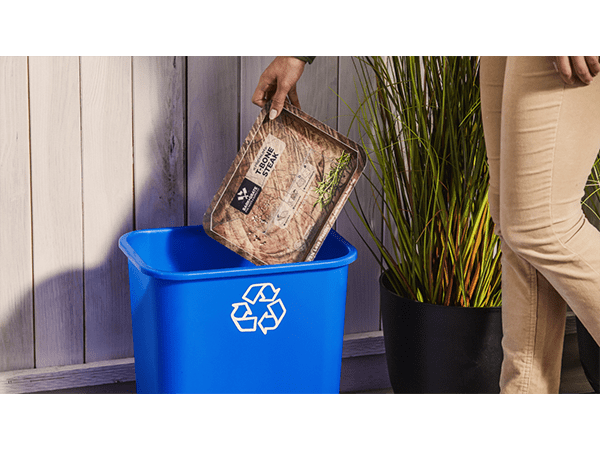Artikel
Die überraschende Wirkung eines Pappbechers

Von morgens bis abends spielen Verpackungen in unserem täglichen Leben eine wichtige Rolle. Ob es der Karton ist, in dem sich Ihre Cornflakes befinden, der Behälter für Ihre Vitamine oder der To-go-Becher für Ihren Kaffee auf dem Weg zur Arbeit. Verpackungen sind immer da, nahtlos in unseren Alltag integriert und bieten Komfort und Zuverlässigkeit, wenn wir sie am meisten brauchen.
Pappbecher gibt es schon seit über hundert Jahren. Wir füllen sie mit heißen Getränken für kalte Winternächte und erfrischenden Drinks für heiße Sommertage. Pappbecher sind die heimlichen Helden im Alltag von Millionen vielbeschäftigten Verbrauchern.
Für Betreiber von Schnellrestaurants und kleinen Lebensmittelgeschäften mit To-go-Angebot werden die Vorteile von Pappbechern für das Geschäft und die Kunden immer wichtiger.
Nicht alle Becher sind gleichwertig
Für die Mitnahme von Getränken stehen nicht nur Pappbecher zur Verfügung. Es gibt auch Becher aus Plastik, Schaumstoff und Mehrwegmaterial. Jeder Becher hat seine eigene Nachhaltigkeitsgeschichte, aber nicht alle erzählen die ganze Geschichte, und die Verbraucher werden sich dessen bewusst.
Beispielsweise wird Kunststoff in vielen privaten Recyclingströmen angenommen. Die Realität ist jedoch, dass nur neun Prozent des Plastikabfalls tatsächlich verwertet wird – der Rest wird verbrannt oder auf einer Mülldeponie entsorgt. Im Jahr 2024 wurden in den USA rund 220 Millionen Tonnen Plastikmüll produziert, was die Bedeutung starker Endmärkte für die Wiederaufbereitung von Materialien zur Herstellung neuer Produkte unterstreicht.
Die Tatsache, dass dieser Teil der Geschichte oft weggelassen wird, gestaltet sich für Gesetzgeber zunehmend zu einem Problem. In der Klage des Staates Kalifornien gegen ExxonMobil warf der Generalstaatsanwalt von Kalifornien dem Petrochemie-Riesen vor, „die Öffentlichkeit hinsichtlich der Recyclingfähigkeit von Plastik in die Irre geführt zu haben“. Diese Klage bezieht sich ausdrücklich auf Statistiken, die zeigen, dass selbst mit der Einführung des chemischen Recyclings 92 % des Kunststoffabfalls nicht erfolgreich in nutzbares Kunststoffmaterial recycelt werden kann.
Die Recyclingquote für Pappbecher ist relativ niedrig, doch die Rückgewinnungsquote ist hoch und es gibt starke Endmärkte für recycelte Becher, die daraus neue Pappverpackungen und andere Papierprodukte herstellen können. Wir beobachten, dass US-Bundesstaaten versuchen, die Engpässe beim Zugang zum Recycling durch EPR-Initiativen (Extended Producer Responsibility) und Branchenvertreter auf lokaler Ebene anzugehen, aber der Prozess geht nur langsam voran. Pappbecher sind dafür konzipiert, wiederverwertet zu werden. Die Aufgabe besteht also darin, Kommunen dazu zu bringen, das Material in ihre Recyclingkreisläufe aufzunehmen und den Verbraucher über die ordnungsgemäße Entsorgung aufzuklären.
Sobald ein Pappbecher in der Recyclingtonne landet, besteht eine hohe Chance, dass er wiederverwertet wird. Warum ist das so? Mit dem technologischen Fortschritt in der Pappherstellung und dem Wunsch, Becher einzusammeln und daraus etwas Neues zu machen, sind die Endmärkte ideal vorbereitet, dieses Material zu verarbeiten. Über 40 Anlagen in ganz Nordamerika nehmen mittlerweile Pappbecher zum Recycling an. Die Branche muss jedoch mehr von diesem Material in den Recyclingkreislauf einbringen, wenn die Nachfrage nach Produkten aus recycelten Materialien bei den Verbrauchern weiter steigt.
Was denken Verbraucher WIRKLICH über Becher?
Eine kürzlich von der Shelton Group für Graphic Packaging durchgeführte Studie ergab, dass 78 % der Verbraucher über die Umweltauswirkungen von Plastikbechern im Vergleich zu Papierbechern sehr oder etwas besorgt sind. Und drei Viertel der Befragten betrachten Papierverpackungen als „umweltfreundlicher“. Eine weitere Studie kam zu dem Ergebnis, dass die Verbraucher die Papierindustrie insgesamt als „vertrauenswürdiger“ ansehen als die Kunststoffbranche.
Verbraucher machen sich nicht nur Gedanken über die Umweltauswirkungen, sondern erwarten auch, dass Getränkeverpackungen ihrer Funktion gerecht werden. Marktforschungsergebnisse des Marktforschungsunternehmens Technomic zeigen, dass 84 % der Verbraucher die Isolierleistung eines Bechers als äußerst oder mäßig wichtig für Kaltgetränke einstufen, verglichen mit 43 %, die die Sichtbarkeit des Getränks durch das Bechermaterial als wichtig erachten. Auch hier überzeugen Pappbecher auf ganzer Linie. Bestes Beispiel: unsere Innovation Cold&Go. Für die Entwicklung haben wir unsere 15-jährige Erfahrung in der Optimierung der Technologie für isolierte Becher genutzt. Die Leistung dieses Produkts kann sich sehen lassen – die Qualität des Getränks bleibt erhalten und die Kondensation wird reduziert.
Pappbecher sind die richtige Entscheidung
Es ist wichtig, bei der Verpackungswahl mitzudenken. Für den Verbraucher muss sie funktional sein, die richtige Markenbotschaft vermitteln und im Gastronomiebetrieb problemlos funktionieren. Wenn diese drei Faktoren erfüllt werden, erhalten Sie eine Verpackung, die unseren Alltag nahtlos ergänzt. Sie bietet Verbrauchern ein zufriedenstellendes Sinneserlebnis, wenn sie ihr Lieblingsgetränk schlürfen und genießen.
Mit der Entscheidung für Pappbecher zeigen Schnellrestaurants, dass ihnen die Erde und alle Lebewesen auf dem Planeten am Herzen liegen. Die stärkere Nachfrage nach Papier ermutigt Landbesitzer, in die Pflege unserer wertvollen Wälder, den Erhalt lebenswichtiger Ökosysteme und die Unterstützung der ländlichen Wirtschaft zu investieren. In diesem Video wird die Geschichte eines solchen Landbesitzers erzählt.
Die Botschaft an die Betreiber ist laut und deutlich: Entscheiden Sie sich für Pappbecher und zeigen Sie, dass Ihnen Ihre Kunden, Ihr Unternehmen und der Planet am Herzen liegen.



